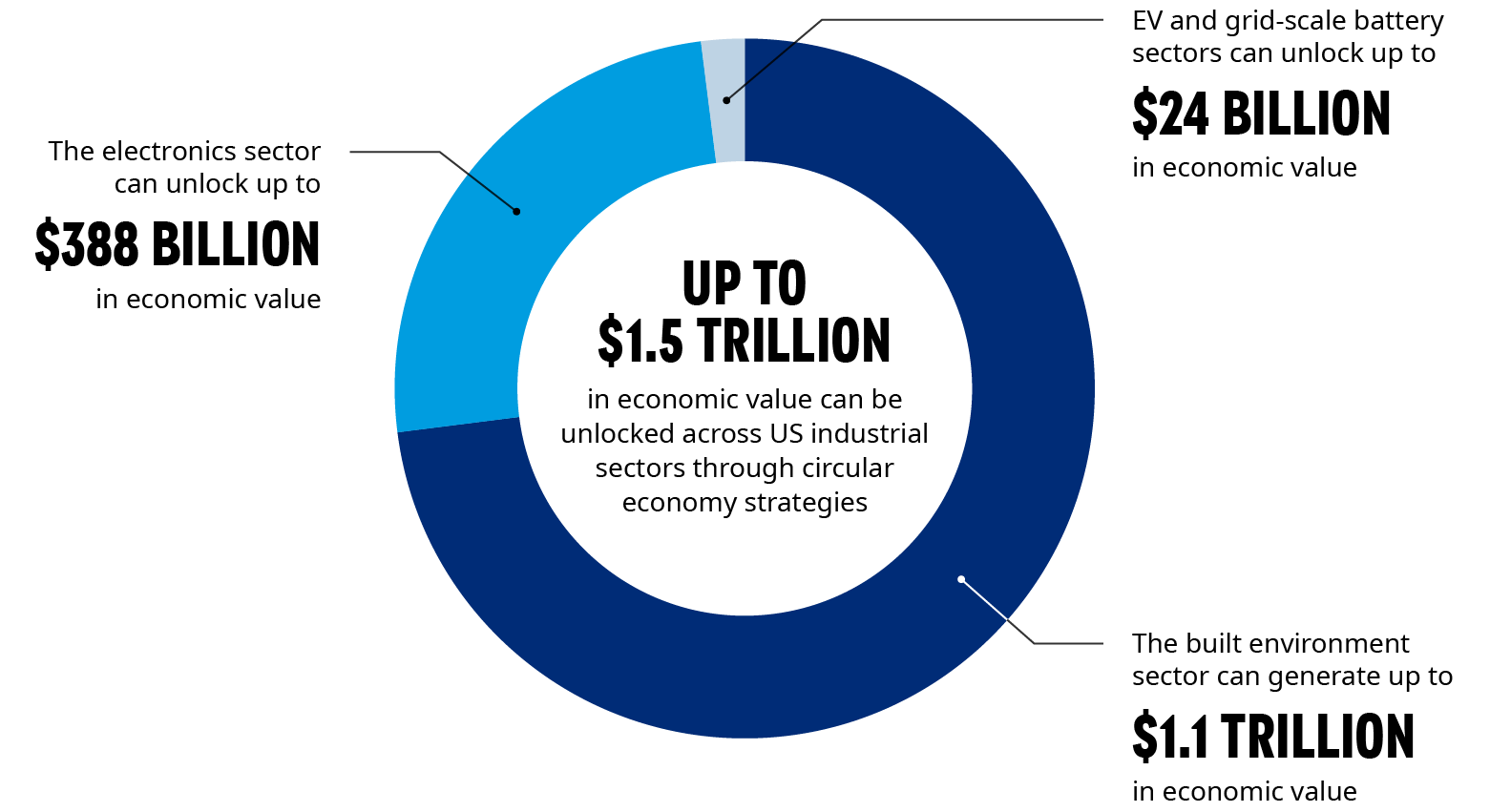The circular economy offers a vision of a future where value creation no longer relies on the consumption of finite resources. Rather than being wasteful and polluting, the circular economy business model is restorative by design. It presents a strong case for long-term prosperity, security, and innovation that is not only nature-positive but can also be designed to deliver environmental justice objectives. Research conducted in partnership with the Ellen MacArthur Foundation identifies how circular economy strategies can help the United States meet its emission-reduction targets across sectors, including in the crucial area of industrial decarbonization.
Our analysis shows there is a substantial environmental and economic opportunity for the United States in a transition to a more circular economy. We looked at how three different industrial activities could benefit from the circular economy — electric vehicles (EV) and battery manufacturing, the built environment, and the electronic equipment sector. Moving to a circular economy could cut raw material inputs to these industries and unlock $883 billion to $1.5 trillion in new revenue and economic value, which represents 4% to 7% of US gross domestic product. It also would reduce annual greenhouse gas (GHG) emissions by 370 million to 850 million tons of carbon dioxide equivalent (CO2e). That amounts to a decline of between 7% and 16% of total US GHG emissions.
Our report, “An Innovation Pathway To Decarbonization: Circular Economy Solutions For Policymakers And Industry,” explores how industry leaders can tap into these benefits by understanding the circular economy’s industry-specific opportunities and barriers, implementing responsive policies, and investing in innovation.

How US industry leaders can harness circular economy benefits
Leveraging Circular economy solutions for EV and battery manufacturing
In large-scale battery production, including both batteries for EVs and storage battery capacity, the valuable raw materials involved — such as lithium, cobalt, and nickel — often represent a supply-chain risk because of where they are mined and the predictability of supply. Battery manufacturing is, in this way, ripe for circular solutions that would keep supplies of these key raw materials circulating within the US economy. The US EV and grid-scale battery markets are estimated to be around $78 billion today. They are projected to almost triple to nearly $193 billion by 2030, according to an Oliver Wyman analysis of data from the US Department of Energy, Fortune Business Insights, and Statista. Applying circular solutions to the battery manufacturing, especially given its anticipated expansion, can significantly reduce GHG emissions, lower toxicity, protect national security, and improve environmental outcomes. Our analysis suggests that circular models within the battery industry can generate approximately $6 billion to $24 billion in economic value for industrial companies and reduce GHG emissions by 2 million to 3 million tons of CO2e. The economic value is primarily driven by cost savings stemming from the reuse of raw materials and the incorporation of new industrial technologies. The cut in GHG emissions would be the result of reduced extraction and production emissions due to extended lifecycles.
Embracing circular solutions in the built environment
The US spends nearly $2 trillion on construction annually, according to US Census Bureau. Our analysis, based on Census data, projects that spending to increase to $2.7 trillion by 2030. Roughly half of this goes toward materials, including carbon-intensive steel, particularly steel produced outside the US where blast furnaces and coke are still the prevalent technology, concrete, and glass. There is ample opportunity for circular solutions in the built environment space with the recycling and product redesign of these materials. Our analysis suggests that more circular models within the built environment could generate between $575 billion to $1.1 trillion in economic value for industrial companies and reduce GHG emissions by 295 million to 538 million tons of CO2e. These significant opportunities are driven largely by the reduction of raw materials (and emissions associated with virgin production) through design and the reuse of carbon-intensive materials like steel.
Boosting electronic utilities industry with circular models
The US electronics industry is valued at around $382 billion today, according to the US Bureau of Economic Analysis. About 60% of the value comes from raw materials. These materials include carbon-intensive steel, aluminum, and plastic. Circular solutions can help decarbonize the electronics space including through product design and novel business models. Our analysis suggests that additional circular models within the electronics industry can generate approximately $301 billion to $388 billion in economic value for industrial companies and reduce GHG emissions by 73 million to 311 million tons of CO2e. These opportunities are primarily driven by a reduction in raw material costs due to fewer materials being needed, and more strategic reuse of originally waste materials. A robust ecosystem of recyclers, either within industry or in the broader marketplace, could help ensure that the approximately $7.5 billion value of US electronic scrap is captured rather than sent to disposal facilities.


